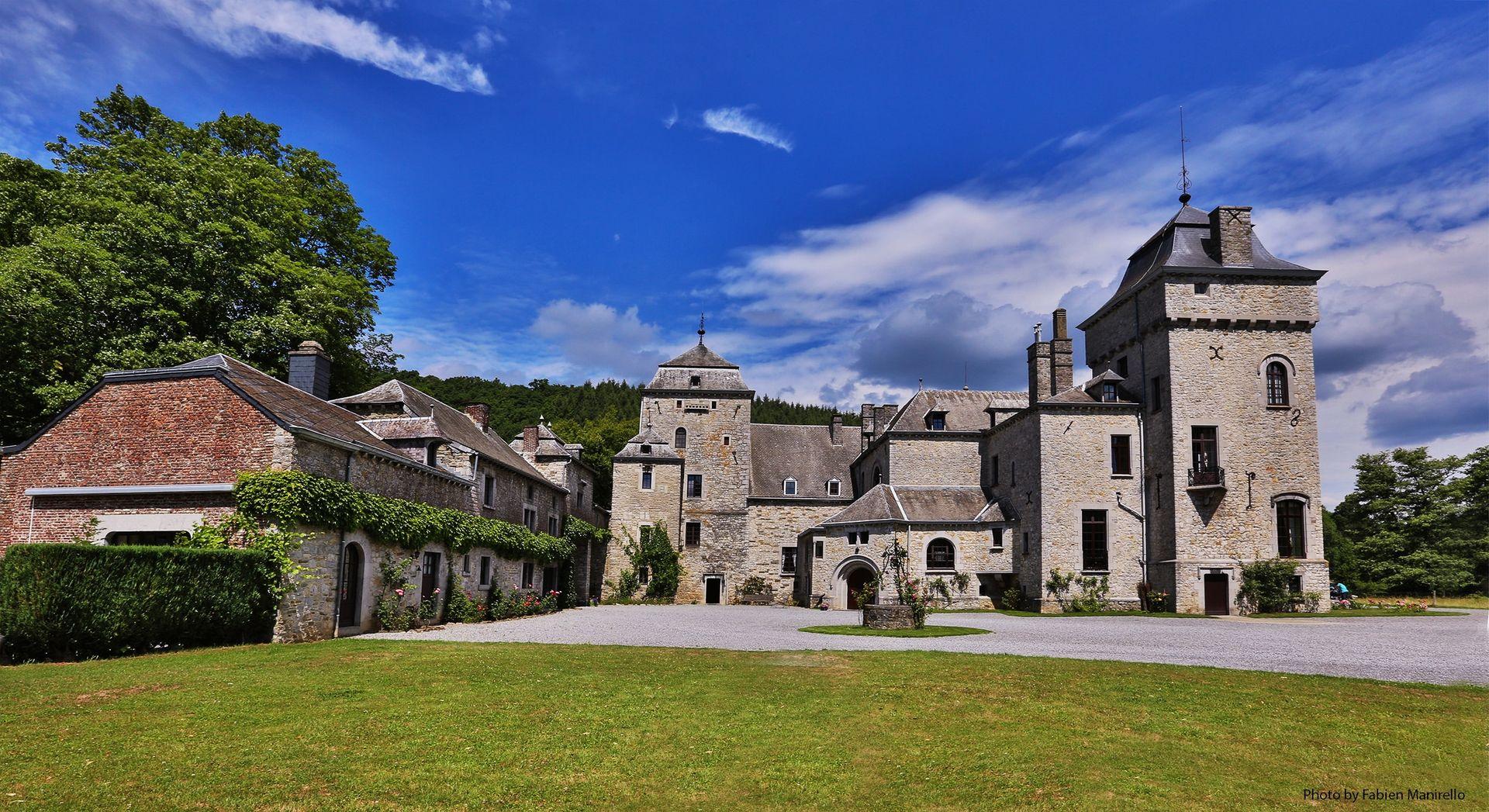LASSUS CASTLE
Lassus Castle, set in the picturesque village of Hamoir along the Ourthe River, is a historic residence full of character.
To breathe new life into the estate, the current owners, Sabine and Jean-François Rancelot, have transformed part of the castle into charming holiday rentals.
PRESENTATION
Built in three different periods, the 13th, 18th and 19th centuries, this castle is an interesting architectural ensemble. The building, surrounded by gardens and a landscaped park, is set in an exceptional green setting, the Ourthe valley immortalised by the great painter Richard Heinz, the “Master of Sy”.
LONGCHAMPS CASTLE
Nestled in the rolling landscapes of Liège’s Hesbaye region, the prestigious Selys-Longchamps Castle is a remarkable example of Empire-style architecture. Still inhabited by Chantal della Faille de Leverghem and her children, descendants of the Selys-Longchamps family, it stands as a testament to its rich heritage.
PRESENTATION
Originally, a Renaissance-style estate, the castle was transformed between 1805 and 1815 under Michel-Laurent de Selys-Longchamps and his wife, Marie-Denise Gandolphe, an avid art enthusiast.
The property features a vast landscaped park, where a majestic tulip tree welcomes visitors at the entrance. The castle and a distinctive pavilion, inspired by Napoleon’s Egyptian campaign tent, frame the grand courtyard. This exceptional structure, attached to the main building, is classified as an outstanding heritage site of Wallonia.
PRIEURE DE BEAUFAYS
Nine centuries ago, a community of canons settled on a hill south of Liège, in a place known as “Belle-Fontaine”. They built a church, a keep, a priory, a farm, and a brewery.
Today, the main part of the estate still belongs to the Laloux family, who acquired it in 1890.
PRESENTATION
Founded in 1123, Beaufays Abbey has witnessed over nine centuries of history, first under the authority of the Bishop of Verdun, then under the Prince-Bishop of Liège. Following the French Revolution, the estate was sold in 1796. After passing through several owners and serving as a girls’ boarding school in 1875, the Liège industrialist Adolphe Laloux purchased Beaufays in 1890. He undertook major restoration works and designed stunning landscaped gardens.
Built in 1701, the current church is an architectural Baroque-style masterpiece. The estate also houses the recently restored Henri de Goha Pavilion, a jewel of Liège’s heritage, featuring a remarkable Louis XIV stucco ceiling adorned with oak and acanthus leaves.
Le domaine abrite également le pavillon Henri de Goha, un petit joyau du patrimoine architectural liégeois. Restauré en 2024, il est orné d’un plafond stuqué de style Louis XIV, aux motifs de feuilles d’acanthe et de chêne.
In collaboration with a local brewery, the abbey continues to make the “Prieuré de Beaufays”, an abbey beer inspired by centuries-old Augustinian brewing tradition.
REINHARDSTEIN CASTLE
Perched on a rocky outcrop in the heart of the High Fens, Reinhardstein Castle proudly overlooks the Warche River. It is the only Eifel style castle in Belgium and the highest in the country.
The castle is owned by the non-profit organisation Reinhardstein, which is dedicated to preserving, enhancing, and bringing this historic site to life.
PRESENTATION
In 1354, Wenceslas of Luxembourg granted Renaud de Waimes permission to build a castle on this site. Over the centuries, it changed hands between several noble families, including Zivelle, Schwarzenberg, Brandscheid, Spontin, and Nassau.
In 1550, following the marriage of Anne of Nassau and Wilhelm von Metternich, the castle became part of this influential Rhineland dynasty, which retained it until the French Revolution. Left abandoned for over 150 years, it fell into ruin until 1965, when historian Jean Overloop took on the challenge of restoring it. With the help of local craftsmen and a group of friends, he meticulously rebuilt the castle over eighteen months, establishing a non-profit organisation to support its revival.
VILLA LE VERT BOIS
VILLA LE VERT BOIS
Villa Le Vert Bois is an elegant 19th-century residence located opposite the Promenade de Sept Heures in Spa. In July 2021, this historic spa town was added to UNESCO’s World Heritage List of “Great Spa Towns of Europe” alongside ten other renowned European thermal destinations.
Respectfully restored to preserve its original character, the Villa now houses a charming Bed & Breakfast and serves as a showroom for interior designer Luca de La Pagerie, who showcases his craftsmanship here.
PRESENTATION
Built around 1845 for Gabrielle Rouma, Villa Le Vert Bois is one of the oldest remaining examples of a spa retreat in Spa. Thanks to a meticulous restoration, it has retained its authentic charm.
From the very beginning, the villa was designed in the Anglicised romantic style, drawing inspiration from Gothic and medieval architecture. It is surrounded by a small-enclosed garden, bordered by a decorative wrought-iron fence. Notable architectural features, such as the brick frieze supporting the cornice and the ornamental faux arrow slits, remain intact. Between 1890 and 1910, the villa was further enhanced with two beautiful glass greenhouses, adding to its refined aesthetic.
WALEFFE CASTLE
Niché dans un cadre naturel d’exception, le château de Waleffe, érigé en 1706, est l’extension d’une ferme fortifiée datant du XVIè siècle. Classée au patrimoine exceptionnel de Wallonie, il appartient depuis 1580 à la famille des barons de Potesta de Waleffe, descendants directs du Grand Curtius, célèbre industriel et grand mécène de la ville de Liège.
PRESENTATION
Le château de Waleffe incarne l’élégance du style classique du XVIIIe siècle. Son intérieur somptueusement décoré mélange les influences Louis XIV et Louis XV, offrant un cadre raffiné avec meubles d’époque, tapisseries et œuvres d’art. Inspiré par l’architecte Daniel Marot, le château marie simplicité et sophistication. Ce lieu a joué un rôle stratégique durant la Seconde Guerre mondiale en servant de refuge pour des membres de l’Armée secrète.
Le parc, avec son allée de tilleuls et sa charmille bicentenaire, fut réaménagé au XIXe siècle. Des sculptures en terre cuite ornent la cour d’honneur, tandis qu’un jardin en broderie témoigne du raffinement paysager d’autrefois. Un espace dédié à l’herboristerie propose des ateliers sur les plantes médicinales et la phytothérapie.
WARFUSEE CASTLE
Located in Saint-Georges-sur-Meuse, Warfusée Castle is a masterpiece of 18th-century architecture. Still home to the Counts of Oultremont, it embodies the elegance of the Louis XV era and is recognised as an exceptional heritage site of Wallonia.
PRESENTATION
Originally, a medieval seigneury, Warfusée belonged successively to the de Dommartin, Hamal, and Renesse families. At the time, it featured a Renaissance-style keep and main residence. In 1609, the Holy Roman Emperor elevated it to a county.
. In 1707, Marie-Isabelle of Bavaria-Schagen brought the estate into the Oultremont family through her marriage to François d’Oultremont. The present castle was built in 1754 by Florent d’Oultremont, brother of Prince-Bishop Charles-Nicolas d’Oultremont. Its harmonious neoclassical architecture, the grand avenue leading to the 1622 gatehouse, and perfectly symmetrical outbuildings make it a remarkable sight. Perched 130 meters above the Meuse, its landscaped park, complete with a pond, offers breathtaking views.
Inside, the castle displays 18th-century refinement, with exquisite marble, wood paneling, stucco, and wrought iron. The private apartments of the Prince-Bishop feature a four-poster bed, Oudenaarde tapestries depicting Don Quixote, and portraits of Louis XV and Louis XVI.




















